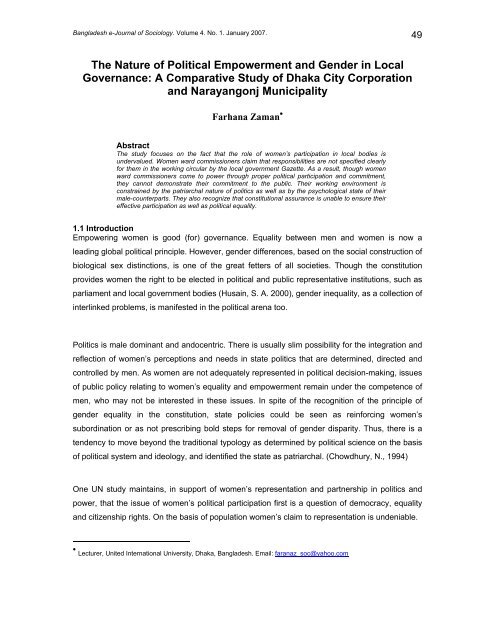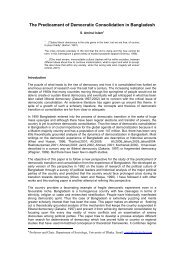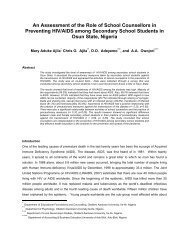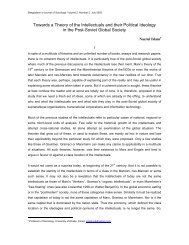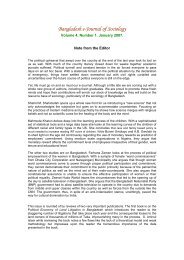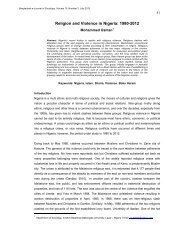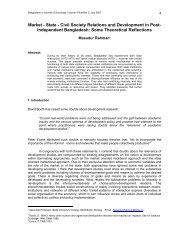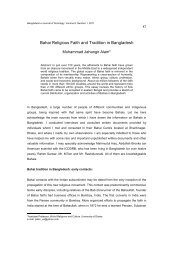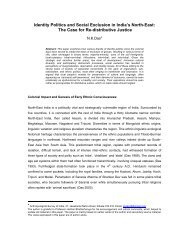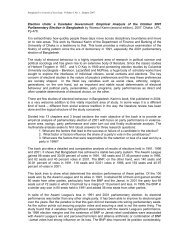Farhana Zaman - Bangladeshsociology.org
Farhana Zaman - Bangladeshsociology.org
Farhana Zaman - Bangladeshsociology.org
- No tags were found...
You also want an ePaper? Increase the reach of your titles
YUMPU automatically turns print PDFs into web optimized ePapers that Google loves.
Bangladesh e-Journal of Sociology. Volume 4. No. 1. January 2007.49The Nature of Political Empowerment and Gender in LocalGovernance: A Comparative Study of Dhaka City Corporationand Narayangonj Municipality<strong>Farhana</strong> <strong>Zaman</strong> •AbstractThe study focuses on the fact that the role of women’s participation in local bodies isundervalued. Women ward commissioners claim that responsibilities are not specified clearlyfor them in the working circular by the local government Gazette. As a result, though womenward commissioners come to power through proper political participation and commitment,they cannot demonstrate their commitment to the public. Their working environment isconstrained by the patriarchal nature of politics as well as by the psychological state of theirmale-counterparts. They also recognize that constitutional assurance is unable to ensure theireffective participation as well as political equality.1.1 IntroductionEmpowering women is good (for) governance. Equality between men and women is now aleading global political principle. However, gender differences, based on the social construction ofbiological sex distinctions, is one of the great fetters of all societies. Though the constitutionprovides women the right to be elected in political and public representative institutions, such asparliament and local government bodies (Husain, S. A. 2000), gender inequality, as a collection ofinterlinked problems, is manifested in the political arena too.Politics is male dominant and andocentric. There is usually slim possibility for the integration andreflection of women’s perceptions and needs in state politics that are determined, directed andcontrolled by men. As women are not adequately represented in political decision-making, issuesof public policy relating to women’s equality and empowerment remain under the competence ofmen, who may not be interested in these issues. In spite of the recognition of the principle ofgender equality in the constitution, state policies could be seen as reinforcing women’ssubordination or as not prescribing bold steps for removal of gender disparity. Thus, there is atendency to move beyond the traditional typology as determined by political science on the basisof political system and ideology, and identified the state as patriarchal. (Chowdhury, N., 1994)One UN study maintains, in support of women’s representation and partnership in politics andpower, that the issue of women’s political participation first is a question of democracy, equalityand citizenship rights. On the basis of population women’s claim to representation is undeniable.• Lecturer, United International University, Dhaka, Bangladesh. Email: faranaz_soc@yahoo.com
Bangladesh e-Journal of Sociology. Volume 4. No. 1. January 2007.50Secondly, the feeble presence of women in politics raises questions about the decisions taken inthe political arena and the legitimacy of democratic system. There occurs a vast disjunctionbetween women and the democratic state due to the insufficient presence and limitedparticipation of women in political structures and processes. (Chowdhury, N., 1994)The third argument rests on the differences of interests of men and women. Women are directlyaware of their basic problems and needs. But women are denied the opportunity to articulate andsafeguard their interests, if they are not adequately represented in politics. (Chowdhury, N., 1994)Fourth, women’s large-scale entry in politics will bring about a desirable shift in the existingfocus of politics. Those issues that are now viewed as personal because they relate to women’slives and concerns and are thus considered as being outside the jurisdiction of real politics wouldcome to be regarded as political issues. (Chowdhury, N., 1994)Finally, the study notes that women’s strong presence in politics is justified for the effective use ofhuman resource. However, women do not constitute an un-differentiated social entity. From thevantage point of Contemporary Marxian Feminism, the quality of each individual’s lifeexperiences is a reflection first of his or her class position and only second of his or her gender.Women of markedly different class backgrounds have fewer life experiences in common thanwomen of any particular class have with the men of their class. For this reason, they are not ableto constitute one homogeneous interest group. (Chowdhury, N., 1994)Again, there are differences among women, which are rooted in many existing social divides.There exist differences among women on the basis of class structure; geographical or situationaldifferences; some differences are constructed on binary relations. There are differences amongwomen determined by their class and status in society. Again, there are differences amongwomen on the basis of society and culture. This wide applicability of this theory of differencenevertheless hints at a basic feature, which is that within the class or situational context, women’sstatus is unequal and subordinate to that of men. This overriding difference based on gender,which is pervasive as a fundamental determinant in structuring genders relations, binds womentogether in one universal bond of a community. Women’s subordination manifests in many ways.There are gender differences in ownership, authority and decision-making, which are reflected inthe discrimination, oppression and repression of women. Therefore, the question of women’spolitical participation is closely linked to the realization and awareness of many dimensions ofunequal status of women. Thus, the social consciousness about this unequal status of womencan be able to change the whole situation. (Chowdhury, N., 1994)
Bangladesh e-Journal of Sociology. Volume 4. No. 1. January 2007.51Throughout the world, women continue to face inequality and as a result are deprived of socialrewards such as money, power and prestige. Unless women are involved in the decision andpolicy making processes at all levels of the state, changes in women’s political and to someextent social and economic status will continue to remain marginal. The present study has been<strong>org</strong>anized to examine the nature of women’s participation in politics and to identify the factors,which work as obstacles in their satisfactory performance as compared to those of men of DhakaMunicipal Corporation and Narayanganj Municipality.1.2 Objectives of the StudyThe study is broadly an attempt to analyze the emerging scenario of women leadership at urbanlocal level politics by focusing on the women representatives compared to their male counterpartsof the Dhaka Municipal Corporation and Narayanganj Municipality. It is also an attempt to make acomparative analysis of the nature of political empowerment of Dhaka Municipal Corporation andNarayanganj Municipality.More specifically, the study intends• To assess the nature of political involvement and empowerment of women and menelected as commissioners of Dhaka Municipal Corporation and NarayanganjMunicipality.• To identify the functions of the ward commissioners of the two areas.• To examine the role of gender in the functioning of urban local political institutions andfocus on a comparative perspective on the experience of two areas.• To identify the constraints and problems faced by women and men commissioners asrepresentatives in the urban local bodies.Along with these objectives, the research is looking at a fundamental question, i.e.To what extent women’s participation make a difference from their male counterparts?1.3 MethodologyThe study has been conducted in two neighboring districts of Bangladesh: Dhaka andNarayanganj. Both Dhaka Municipal Corporation and Narayanganj Municipality are themunicipalities of class-1 category. To satisfy the purpose it was needed to include arepresentative number of women and men Ward Commissioners of Dhaka City Corporation andNarayanganj Municipality. A total of 60 respondents were selected to collect information about theresearch. Among them, 48 are from Dhaka Municipal Corporation and the rest of them are fromNarayanganj Municipality. Among 48 respondents 24 are women and the rest of 24 are mencommissioners. In case of Narayanganj, as it is a very small number to compare with that ofDhaka, all the 12 commissioners were interviewed. They were selected following purposivesampling procedure. The method of interview survey is adopted here because it is the most
Bangladesh e-Journal of Sociology. Volume 4. No. 1. January 2007.52appropriate one to collect data from the commissioners. In present research a combination ofboth structured and unstructured questionnaire is used for getting the advantages of the two andfor the best outcome.1.4 Participation and Representation of Women in Politics in BangladeshHistorically women’s voting right was established long ago but women’s participation in thepolitical and national movement has been negligible. At present both the prime minister and theleader of the opposition in Parliament are women. One of them (Begum Khaleda Zia) was ahousewife and had no political involvement before she made a lateral entry into the party toassume the top leadership role. The other one (Sheikh Hasina) was also a housewife, but hadsome experience as a student leader during her university days. Begum Khaleda Zia is the widowof a former president of Bangladesh who was killed in an abortive coup and the other (SheikhHasina) is the daughter of another former president and first Prime Minister of Bangladesh.The present chairman of the Bangladesh Nationalist Party (Begum Khaleda Zia) was brought into keep her husband’s political party in tact as well as to rejuvenate it. She was ushered into theleadership role from a non-political status as the symbol of her husband to keep the battinggroups in the party from falling apart.As in the case of Bangladesh Nationalist Party, the Awami League also brought the daughter of aformer president to assume the top leadership role as a symbol of her father to save the partyfrom falling into pieces. These two women, on whom leadership roles were suddenly thrust upon,seem to have risen to the occasion. They have not only been successful in ‘crisis management’,but also have led their parties in such a way that these two political parties have become the mainopposition parties of Bangladesh.Political inheritance in Bangladesh is somewhat new in Bangladesh politics. Although suchinstances are not rare in Indian Politics, this is the first time such andheir ship’ has worked sosuccessfully in the politics of Bangladesh.Not only have these two top women leaders served as ‘rallying points’ of their very large partyfollowing (composed of diverse political elements in the case of Bangladesh Nationalist Party),these two political parties have to depend on them, to a very great extent, for the mobilization ofpublic opinion in favour of the party programs. However, these two top women political leadershave been created by special circumstances.However their high position in politics does not reflect the whole scenario of women’s position inpolitics. Observation and study findings reveal that women generally cannot go up the party
Bangladesh e-Journal of Sociology. Volume 4. No. 1. January 2007.53hierarchical ladder in a ‘reutilized’ manner as a man generally can. Women are still subordinatedto men in many cases but they are coming out. Gradually women’s participation is increasing.The increasing political involvement has inspired women to contest for the Rural Union Counciland Urban Municipal Election (there are one third reserved for women) more than before. In thelast union council election (1997) nearly 48000 women contested for the member post. Directlyelected women councilors/members are demanding for their defined responsibilities and Jobs.Table 1: Gender based voters in National Parliamentary ElectionNumbers of votes National Parliament Number of votes Votes caste for UrbanState/Provincial Local GovernmentParliamentscouncilsYear Female Male Female Male Female Male1996 28,759,994 28,956,941 n.a n.a n.a n.a2000 36,239,491 38,463,258 n.a n.a n.a n.aSource: Election Commission Office.Table 2: Representation in national parliament by GenderNational ParliamentUrban Local Govt. CouncilYear F M %19601970198015323002984.89.21990 35 295 10.62000 37 293 11.2 887 2661Source: 1. Journal of Public Administration by PATC vol. 15, June 2000, Dhaka1. List collected from Ministry of Local Govt (four City Corporations are not included here). Ratio of four CityCorporation M:F=190:63 (Source: BBS, 1998)Table 3: Women participation in Federal Cabinet/Executive branch and Urban LocalgovernmentYear Number and Percentage of women in Number and percentage ofFederal Cabinet/executive Branch women MayorsNumber % Number %19601970 02 41980 06 6 Nil
Bangladesh e-Journal of Sociology. Volume 4. No. 1. January 2007.541990 04 31992 03 52000 04 16The Country was under military regime from 1975 to 1990. There was no democratic practice atall during the martial law government. After the fall of the martial law government in 1990,democracy was established in 1991. (Source: Islam, F., 2002).1.5 Women’s Participation in Urban Local GovernmentBefore the Gazette notification (the Pourashava Ordinance 1977, Ordinance No. XXVIof 1977,which was emended on 1998, July, and Gazette additional copy 22/3/1999) for municipalities andcity corporations respectively, female ward commissioners were appointed by selection. For thefirst time Dhaka City Corporation elected 19 female ward commissioners (elected by malecommissioners) for reserve seats in 1994. With a view to promote women’s participation in UrbanLocal Govt. the Pourashava Ordinance and City Corporation Ordinance have been introducedwhich were monetary for every Pourashava and city corporation. These ordinances stipulate thatwhatever the number of ward commissioner, depending on the area of Pourashava and CityCorporation; there should be reserved seats, exclusively for women equivalent to one third of thenumber of commissioners fixed by the Govt. The women ward commissioners will be electeddirectly.The span of responsibilities for ward commissioners has been well-defined in the govt. gazette.But there is no definite responsibility narrated in such a gazette for women ward commissioners.The Govt. Gazette Notification has described the nature of meetings; panel Chairman etc. so thestatus of women ward commissioners has been undermined still there is some confusion andmisunderstanding between commissioners and women ward commissioners.Every political party has a women wing to encourage women to join politics either at National orlocal level. Women’s participation in politics has no doubt increased tremendously. All NGO’sWomen Organizations and Civil Society Organizations are very active in this regard. Recentlythere has been a phenomenal change. During the last 1998 local govt. election (Union Parishad)more than 12000 women members were elected directly for reserved seats. In the near future,after completion of municipal election, another 887 women ward commissioner will be directlyelected. Contesting for reserved seats, women’s participation in election will have a positiveimpact on women’s political consciousness. Beside this, the media are playing a vital roleeducating women. The total number of women voters’ enrolment has increased compared to theprevious enrolment.
Bangladesh e-Journal of Sociology. Volume 4. No. 1. January 2007.55Table 4: Number of voters by sex in the voting year 1991 and 1996Year of Total number Number of voters by sex The ratio of M/F % of votevoting of votersvoterscastingenrolmentMF1991 62181743 33040757 29140986 53.14:46.86 55.44%1996 56887588 28614475 2827313 50.30:49.70 74.80%Source: FEMA, Election Report (1996).From the above table it is seen that the ratio of female voters has increased from 49.7% by theyear of 1991-1996.Local Govt. has initiated different programs to encourage women’s participation in governance.Women ward commissioners mainly deal with women’s issues, particularly for poor women, suchas micro credit programs, handicrafts and professional training programs attracting women to joinsuch programs. There are some positive impacts of such programs initiated by local government.Women are becoming very concerned about their rights and unnecessary cases. Local Govt. arecompelled to facilitate their rights. Very recently the govt. has introduced transport facilities forwomen, childcare facilities, violence against man. All these are the results of the women’smovement. (Source: Islam, F., 2002).1.6 Major Obstacles to Women’s Political Participation in BangladeshAlthough women in Bangladesh enjoy political and legal rights comparable to many otherdeveloped nations, very few Bangladeshi women have entered the political arena and still fewerhave made serious efforts to gain political power through their involvement in the country’spolitics. Even after the war of liberation of 1971, the experiences of which played a significant rolein raising the political consciousness of the women of Bangladesh, politics remains for them avery unusual career (Salauddin, K., 1994).Traditionally women in our country are deprived of the right of decision-making and of effectivepolitical participation. Their roles have been identified as secondary. Their potentiality remainslargely unrecognized and contributions are mostly unpaid. An adequate explanation of thisphenomenon necessitates the identification of the constraints more precisely. Main obstacles towomen’s political participation include the following:(a) Women’s primary responsibility: Traditionally women’s domestic activities areconsidered as their primary responsibilities which keep women isolated from the labormarket. This also limits their interests and serious involvements in politics. In general
Bangladesh e-Journal of Sociology. Volume 4. No. 1. January 2007.56women spend their times with family members such as children and very old people whohardly have knowledge or interests about politics. As a result, women lack scope todiscuss political affairs with people either outside or inside the home and also thefreedom to gain politically relevant experience. Studies in the United States (Anderson,1975, Welch, 1977) find that employment particularly outside home, is associated withdramatic increase in women’s political participation. These factors are more intense in adeveloping country like Bangladesh, where the average number of children per couple ismuch higher than that of the developed countries.(b) Women’s Inferior Economic Status: Economic dependence is the key factor thatworks against the political participation of women in Bangladesh. Gender is a significantfactor in poverty in Bangladesh. Poverty is over represented among women. Empiricalevidence from different studies suggests that incidence of extreme poverty is generallyhigher for the female headed, female managed and female supported households. Bothlabor force survey and micro level household surveys indicate that, female workers earnconsiderably less than the male workers. The vast majority of the populations (about80%) live in the rural areas, where the women experience a disproportionately largeshare of the country’s poverty (UNDP 1994). In Bangladesh, women’s inferior economicstatus keeps women economically dependent on men. This dependence is also animportant factor that limits her freedom to participate seriously in politics.c) Lack of fixed working hours: Politics is an occupation, which does not have anyfixed working hours. Ward commissioners may need to go outside anytime on an urgentbasis. As women are primarily assigned to domestic activities, they might not makethemselves available in a place where they are required on an urgent basis.d) Women’s Educational Status: Women are lagging behind men in all stages ofeducation. Though worldwide literacy rate is improving, in all regions illiteracy remainshigher for women than for men. Of the world’s nearly one billion illiterate adults, twothirdsare women. Approximately, 100 million children, including 60 million girls remainwithout access to primary education and over two-thirds of the world’s 960 millionilliterate adults are women (United Nations 1995:70). This unequal educational status iscontributing negatively on the way to women’s involvement in politics. Women alwayshave a fear of not being able to perform all the activities necessary for politics due to theirinferior educational status.e) Social Norms and Values: In fact, the cultural factors do not support women’sinvolvement in politics. ‘Women in politics’ is a matter of toleration, not a matter ofacceptance. Cultural values and norms are playing a crucial role in socializing a girl and aboy. The occupations, which are especially assigned to a girl from her childhood, are -
Bangladesh e-Journal of Sociology. Volume 4. No. 1. January 2007.57elementary school teacher, nurse, receptionist, personal secretary etc. On the contrary,the field of politics is highly considered as male-dominated.However, in order to improve the situation of women, governments of almost all countries anddifferent national and international NGOs are taking different steps. The Constitution ofBangladesh guarantees certain rights and privileges to women fundamental rights. Moreover, tosafeguard the various constitutional rights, the government has enacted various women-specificand women-related legislation. As a result, gender gap is closing day by day, though much is leftto achieve.In recent years, participation of women in politics has been increased significantly. They all arecontributing significantly to the country’s democratic exercise and some of them are very muchsuccessful in performing their responsibilities. However, as for many years male politicians areinvolved in ‘politics’ as well as ‘local government, these have become male dominatedinstitutions. Women representatives face number of problems, which stand as barriers in theirsatisfactory performance. Under this purview, the later part of this article will focus on some of theproblems those the local level women representatives are facing most.2.1 Participation of women in politicsPolitical participation is one of the major ways to ensure women’s empowerment, to increasedecision-making power and enhance ability to influence matters that affect their lives in thecommunity and in the larger society. In broader sense, participation in politics goes far beyondelectoral politics, such as voting and election to public office. Women’s empowerment begins withher consciousness- perceptions about herself and her rights, her capabilities and potential,awareness of her gender and socio-cultural, economic and political forces that affect her.Women’s political empowerment and equal representation in all decision-making institutions arecritical inputs in the struggle for freedom from patriarchal subjugation (Shamim and Nasreen,2002). This section of the article focuses on the participation of women in two urban local bodiesnamelyDhaka Municipal Corporation and Narayanganj Municipality.Meetings Called Per Month by the City Corporation/ MunicipalityRespondents were asked about the number of meetings called per month in City Corporation/Municipality. Great variation in their opinions is found from the study. In case of DCC, 54 per centrespondents told that at least one meeting is called per month, whereas 38 percent respondentstold that they meet twice/thrice a year. Such a situation indicates about huge communication gap
Bangladesh e-Journal of Sociology. Volume 4. No. 1. January 2007.58between the City Corporation schedules and those who are obliged to follow these schedules fortheir successful performance.In case of Narayanganj, their opinions are more or less same. All but one responded that onemeeting is called per month in their Municipality.Attendance in the Meetings by the Respondents: The sample areas under study have largeindicators to analyze two urban local bodies, their activities and respondents’ role on it.Attendance at the meetings is not only an important indicator for active participation, but also aforum to discuss development activities and decision-making. This study shows that 88 percentwomen ward commissioners regularly attend the corporation meetings as compared to only 25per cent men ward commissioners. A large number of men commissioners (75%) do not attend atmeetings regularly. This clearly indicates that women ward commissioners are more seriousabout corporation activities than that of men.Table 5: Attendance in the Meetings by the RespondentsAttendance DhakaNarayanganjin the Male Female Total Male Female TotalmeetingsRegular 6(25%)21(87.5%)27(56.3%)4(44.4%)3(100%)7(58.3%)Irregular18(75%)3(12.5%)21(43.8%)5(55.6%)- 5(41.7%)Total24(100.0%)24(100.0%)48(100.0%)9(100.0%)3(100.0%)12(100.0%)Source: Fieldwork, 2004.In case of Narayanganj, the same scenario is apparent. All women respondents join regularly inthe Municipal meetings as compared to 45 per cent of the men respondents.Attendance in the corporation/Municipal MeetingRespondents100806040200RegularIrregularDhaka MaleDhaka FemaleNarayanganj MaleNarayanganj FemaleAttendance in the MeetingFigure – 1: Attendance in the Corporation/Municipal Meetings
Bangladesh e-Journal of Sociology. Volume 4. No. 1. January 2007.59If Irregular, Reasons for Non Attendance:Regularly participation in meeting is very important for the commissioners for becoming up-datedabout the corporation/ municipal activities. But the ‘Table no. 1’ shows that a large number of menward commissioners do not attend at meetings regularly. About 67 percent of them told that theydid not get notice in time. As a result, they failed to attend due to some other pre-scheduledtasks. (It should be noted here that women ward commissioners also do not get notice in time.But as they do not miss meetings as they always enquires about corporation activities). About 61percent could not attend due to illness and 56 percent did not attend meeting as because theywere in abroad. It is surprising that 22 percent respondents failed to attend because they f<strong>org</strong>otthe schedule of the meetings.Among the irregular women respondents 67 percent could not attend meetings due to illness.One responded that she does not attend for not getting the opportunity to participate in thediscussion of the meeting. She complained that men commissioners do not give floor to womencommissioners to talk. It is the general scenario, which is applicable to all women wardcommissioners more or less. Despite most of the women commissioners attend the meeting onlyto establish their rights.In case of Narayanganj, all the women ward commissioners are very serious regarding theparticipation in the Municipal meetings. But some men ward commissioners (56%) were irregular.They did boycott meetings for not being given with important responsibilities and due importanceof their opinions. Only 20 percent could not join due to illness.Extent of Participation by the Respondents in Meetings DiscussionThe first hand report (field report) shows that all respondents participate in the meeting discussionmore or less in Dhaka, whereas nearly 60 percent respondents have no participation in case ofNarayanganj. In Dhaka, all men commissioners can participate fully as compared to only 29percent women ward commissioners. More than 70 percent women ward commissionersparticipate partially. Here partial participation means only to join in the meeting and not getting theopportunity to express their own views. Women ward commissioners complained that mencommissioners do not give them floor to speak, rather they laugh at the women wardcommissioners. They opined that they were unable to raise their voices properly because of theirlower representation in the corporation. Some of them opined that chairman ignores women’sviews. They said that their opinions are accepted only when majority support the same. But incase of men’s opinions it is just vice versa.
Bangladesh e-Journal of Sociology. Volume 4. No. 1. January 2007.60Table 6: Extent of Participation by the Respondents in Meetings DiscussionExtent of DhakaNarayanganjparticipation Male Female Total Male Female TotalNo participation - - - 4(44.4%)3(100%)7(58.3%)Partialparticipation- 17(70.8%)17(35.4%)2(22.2%)- 2(16.7%)Full participation 24(100%)7(29.2%)31(64.6%)3(33.3%)- 3(25%)Total 24(100.0%)24(100.0%)48(100.0%)9(100.0%)3(100.0%)12(100.0%)Source: Fieldwork, 2004In case of Narayanganj, data show that only 42 percent respondents do participate in themeeting discussion of which 25 percent respondents are full participants and 17 percent arepartial participants. A larger portion of the respondents has no participation which includes all thewomen ward commissioners. They felt themselves nothing but a living statue in the meeting asthey are only the signatory of the decisions made by the male participants. Their chairman takesall the decision herself, prepares required papers on that and finally just ask for signature fromthem.100Extent of Participation of the RespondentsRespondents806040200No participation Partial participation Full participationExtent of ParticipationDhaka MaleDhaka FemaleNarayanganj MaleNarayanganjFemaleFigure – 2: The Extent of participation of the Respondent
Bangladesh e-Journal of Sociology. Volume 4. No. 1. January 2007.61Standing Committees Headed by Women Ward Commissioners:When the respondents were asked about the number of standing committees formed by the CityCorporation/ Municipality, most respondents of both Dhaka and Narayanganj became confused.A larger portion of men (33%) and women (67%) respondents didn’t know the actual number ofthe standing committees.In fact, no standing committees have yet been formed formally by the City Corporation. But thereare some informal standing committees such as - Market, Technical and Mosquito KillingCommittees (which are waiting to be approved), all of which are headed by men wardcommissioners. But there are some development projects such as revenue committee, slumdevelopment projects which are being headed by the women ward commissioners. Again eachward has an urban development center (UDC), which is directed by the women wardcommissioners of the respective wards.In case of Narayanganj, the exact number of the standing committees remained undisclosed. TheChairman of Narayanganj Municipality informed that no standing committee was headed by thewomen ward commissioners. She told that reserve seated commissioners do not have the right ofheading any committees.2.2 The Nature of Functions of the Ward Commissioners:Due to rapid urbanization, the role and functions of urban local government institutions inBangladesh have been gaining in significance in the recent year. Gender empowerment isdetermined by the degree to which women and men participate actively in all these activities andtake part in decision-making. But there are no clearly specified responsibilities given to womenward commissioners by the local government Gazette. As a result, women ward commissionersare unable to show their commitment to public or to the office. This section focuses on thedifferent types of functions of the two urban local bodies performed by women and men wardcommissioners.Responsibilities Given by the City Corporation/ Municipality to the RespondentsThe data reveal significant differences between responsibilities of men and women wardcommissioners. In Dhaka City Corporation, almost all the men ward commissioners are givenwith the responsibilities of corruption and smuggling protection, provision of birth, succession,nationality and character certificates, provision of street light and keeping pollution freeenvironment followed by infrastructure development (96%), maintaining proper drainage and
Bangladesh e-Journal of Sociology. Volume 4. No. 1. January 2007.62sewerage system (92%), encouraging people to pay tax (79%), provision of public toilet andwater supply system (75%) and to participate in the tree plantation programme (70%).But in case of women the scenario is totally different. Almost all the women are involved injudging the women and child issues, welfare of the local people, motivating people during naturalcalamities, provision of birth, nationality and character certificates followed by encouraging peoplein income generating activities (95.83%), motivating people in family planning and health care(95.83%), involving poor women in development activities (91.66%) and motivating people aboutliteracy (91.66%). The participation of men in all those sectors mentioned above is very less.Again the sectors where the involvement of men is very high, participation of women in thosesectors is really insignificant except infrastructural development (87.5%). Some wardcommissioners perform some other activities such as numbering of houses, control over trafficand public vehicles etc. Many women ward commissioners work for keeping the environment freefrom pollution even not being given with this task by the Corporation.Table 7: Responsibilities Given by the City Corporation/ Municipality to the RespondentsResponsibilities givenNarayanganjDhakaMale Female Total Male Female TotalEnsuring infrastructural development &2321449312maintenance(95.83%)(87.5%)(91.66%)(100%)(100%)(100%)Corruption & smuggling protection &2410348- 8maintenance of discipline(100%)(41.66%)(72.91%)(88.88%)(66.66%)Encouraging people in income increasing12324- 33projects(4.16%)(95.83%)(50.0%)(100%)(25.0%)Motivating people for family planning - 2323- 33(95.83%)(47.91%)(100%)(25.0%)
Bangladesh e-Journal of Sociology. Volume 4. No. 1. January 2007.63Encouraging people about literacy 62228538(25.0%)(91.66%)(58.33%)(55.55%)(100%)(66.66%)Motivate people about health care - 2323- 33(95.83%)(47.91%)(100%)(25.0%)Provide birth, succession, nationality &2424489312character certificate(100.0%)(100%)(100%)(100%)(100%)(100%)Provide public toilet & water supply181129819system for local people(75.0%)(45.83%)(60.41%)(88.88%)(33.33%)(75%)Co-operate in enumeration 7- 72- 2(29.16%)(14.58%)(22.22%)(16.66%)Provide public library, amusement98172- 2facilities & its maintenance(37.5%)(33.33%)(35.41%)(88.88%)(16.66%)Encouraging people in cultural activities 139224- 4(54.16%)(37.5%)(45.83%)(44.44%)(33.33%)Awareness about natural calamities &52429224relief distribution(20.83%)(100%)(60.41%)(22.22%)(66.66)(33.33%)Maintaining proper drainage & sewerage2214369- 9system(91.66%)(58.33%)(75.0%)(100%)(75.0%)
Bangladesh e-Journal of Sociology. Volume 4. No. 1. January 2007.64Keep environment pollution free 2413379110(100%)(54.16%)(77.08%)(100%)(33.33%)(83.33%)Welfare of local people (protect dowry,22426- 33early marriage, acid throwing)(8.33%)(100%)(54.16%)(100%)(25.0%)Register birth, death & marriage - 88- 22(33.33%)(16.66%)(66.66%)(16.66%)Encourage people to pay tax, fee etc 19322819(79.16%)(12.5%)(45.83%)(88.88%)(33.33%)(75.0%)Provision & maintenance of street light 24(100%)9(37.5%)33(68.75%)7(77.77%)Provision & maintenance of slaughter - - - 3houses(33.33%)- 7(58.33%)- 3(25.0%)Distribute VGD & VGF card - - - 9(100%)3(100%)12(100%)Participate in tree plantation program 176231- 1(70.83%)(25.0%)(47.91%)(11.11%)(8.33%)Judge the child & women violence cases 152439235(62.5%)(100%)(81.25%)(22.22%)(100%)(41.66%)
Bangladesh e-Journal of Sociology. Volume 4. No. 1. January 2007.65Involve poor women in development22224- 33activities(8.33%)(91.66%)(50.0%)(100%)(25.0%)Others - 119312(4.16%)(2.08%)(100%)(100%)(100%)Source: Fieldwork, 2004Note: i) This is a multiple response tableii)Parentheses present percentage on the basis of the respondentsIn case of Narayanganj it is found that all the respondents irrespective of men and women aregiven with the task of ensuring infrastructural development, distribution of VGD and VGF card andprovision of birth, character and nationality certificates. All the men are specially involved inmaintaining proper drainage and sewerage system and keeping the environment free frompollution followed by corruption and smuggling protection (89%), provision of public toilet andwater supply system (89%), encouraging people to pay tax (89%) and provision and maintenanceof street light (78%). Like DCC, the nature of the women functions is much different than that ofthe men. All the women are involved in encouraging people in income generating projects,motivating people for family planning, encouraging people about literacy, motivating people abouthealth care, welfare activities for the local people, to judge the child and women’s violence cases,followed by creating awareness about natural calamities. The participation of men in suchactivities is very less. All the respondents of Narayanganj Municipality perform some otheractivities such as - naming of roads, numbering of houses, controlling the super markets,eradication of mosquitoes, reception of distinguished visitors etc.The nature of functions given to the commissioners by the local bodies is very much similar. Butthe function of distributing VGD and VGF card is practiced only in Narayanganj. Anothersignificant difference is that commissioners of DCC are enjoying full freedom in selecting thedevelopment activities. They give plan and take approval by the chairman and distribute the workamong the contractors and supervise it personally. But in case of Narayanganj, commissionersonly look after the development activities and their chairman performs all other formalities.Activities those specially address women
Bangladesh e-Journal of Sociology. Volume 4. No. 1. January 2007.66All women respondents of DCC and Municipality mentioned almost the similar type ofresponsibilities. The activities which specially address women are generally - to encouragepeople in various income generating activities, motivate people about family planning,demonstrate people about literacy, motivate people about health care, provide birth, succession,nationality and character certificate, provide public toilet and water supply system for the localpeople, make people aware about natural calamity and relief distribution, keep environment freefrom pollution, look after the welfare of the local people specially women and child, protect dowry,early marriage, acid throwing etc, judge the child and women violence and to take effective stepsto involve poor women in development activities.But there are also some differences in the responsibilities performed by the women wardcommissioners of two local bodies. The women ward commissioners of Narayanganj are alsoinvolved in taking possession of governmental lands. These activities are difficult even for a manto perform properly. But women are performing these activities quite successfully. Againresponsibility to distribute VGD and VGF card is practiced only in Narayanganj, not in Dhaka.It is found in DCC that women are heading some committees like ‘Revenue committee’ and ‘Slumdevelopment committee’ etc and they are really proving their capabilities in performing theseactivities. This type of involvement as well as performance is in deed remarkable in Narayanganj.2.3 Hindrances Faced by the Respondents While Undertaking the City Corporation /Municipal ActivitiesNumerous reasons have prompted the less participation of women representatives in localbodies activities. All of the women ward commissioners of both Dhaka and Narayanganjmentioned that they have been encountering many problems. Some problems are mentioned inthe Table 6. Almost all the women respondents complained that they are given with fewerresponsibilities. They are also facing financial constraint (92%) and immorality of chairman indistribution of corporation activities (92%). The problem of financial crisis is more acute for thosewomen who all are not from rich family background. About 96 percent women reported that theyare always vested with unimportant tasks. They (96%) also complained that male commissionerslaugh at them while participating in meeting discussion. Women ward commissioners are alsofacing some other problems such as - ignoring women in financial affairs (71%) followed bygetting less information about Corporation activities (58%), indirect threat by the male colleagues(46%), restrictions to get involved in work (42%), lack of security (38%), social obligation (33%),very poor honorarium (29%), lack of peoples interests in paying tax (29%), and high rate ofcorruption (21%) etc.On the contrary, 79 percent men ward commissioners do not face any problem in performing theirduties. It has been proved by the co-efficient of correlation as the figure -0.19 indicates that men
Bangladesh e-Journal of Sociology. Volume 4. No. 1. January 2007.67and women are negatively correlated with the hindrances. A very non-significant portion of menfaces some problems due to partiality of the chairman (25%), followed by lack of security (8%),social obligation (4%) and less allocation of work (4%). A male commissioner mentioned that hedoes not feel secured even having 10 security guards. However, he believes that for politicalrepresentatives this situation is a typical one.Table 8: Hindrances Faced by the RespondentsHindrancesDhakaNarayanganjMale Female Total Male Female TotalNo problem 19(79.16%)Social obligation 1(4.16%)Financial constraints 3(12.5%)Immorality of chairman in 6work distribution(25.0%)Partiality of chairman 6(25.0%)Lack of security 2(8.33%)- 19 1 - 1(39.58%) (11.11%)(8.33%)8(33.33%)22(91.66%)22(91.66%)22(91.66%)9(37.5%)Restrictions in involving - 10work(41.66%)High rate of corruption - 5(20.83%)Very poor honorarium - 7(29.16%)Lack of people’s interest in - 7tax paying(29.16%)Less allocation of work 1 24(4.16%) (100.0%)Less responsibilities given - 24to women ward(100.0%)commissionersWomenward - 14commissioners less(58.33%)informedaboutresponsibilities9 - - -(18.75%)25(52.08%)28(58.33%)28(58.33%)11(22.91%)10(20.83%)5(10.41%)7(14.58%)7(14.58%)25(52.08%)24(50.0%)14(29.16%)8(88.88%)3(100.0%)11(91.66%)5 3 8(55.55%) (100.0%) (66.66%)5 3 8(55.55%) (100.0%) (66.66%)- - -- - -- - -2 - 2(22.22%)(16.66%)7 - 7(77.77%)(58.33%)5 3 8(55.55%) (100.0%) (66.66%)- 3 3(100.0%) (25.0%)- - -
Bangladesh e-Journal of Sociology. Volume 4. No. 1. January 2007.68Less interest shown on - 17 17 - - -women program by localelites(70.83%) (35.41%)Male commissioners laugh - 23 23 - 2 2at women ward(95.83%) (47.91%)(66.66%) (16.66%)commissionersIndirectly threatened by - 11 11 - - -male colleagues(45.83%) (22.91%)Ignoring women ward - 17 17 - 2 2commissioners in financial(70.83%) (35.41%)(66.66%) (16.66%)affairsWomen vested with - 23 23 - 2 2unimportant works(8.70%) (7.59%)(9.10%) (16.66%)(95.83%) (47.91%)(66.66%)Others - - - - 1(33.33%)1(8.33%)Source: Fieldwork, 2004.Note: i) This is a multiple response tableii) Parentheses present percentage on the basis of respondentsr = -0.19 [Dhaka (male-female)] Rxy = 0.93 [Narayanganj (male-female)]r = 0.87 [DCC & Narayangonj Municipality (Total)]In case of Narayanganj, 67 per cent respondents irrespective of men and women face problemsdue to the immorality of the chairman and due to her partial attitude. The result of co-efficient ofcorrelation is .93 which means that men and women of Narayanganj Municipality are stronglycorrelated with the hindrances. They also face problems due to lack of funds. It should bementioned here that Narayanganj remained as an abandoned Pourashava for a period of 18years. As a result, there was no political representative during that period. This town is now facinga large number of problems. The Commissioners believed that these problems cannot be solvedwithin next few years with their limited funds. In order to solve all those problems - mainly verypoor condition of roads, another 18 years may take. But the commissioners are hoping for thebest.From the above analysis, it is clearly understood that most of the commissioners of DCC andalmost all the respondents of Narayanganj Municipality are facing numerous problems. Figure .87indicates that the commissioners of both of these two local bodies are strongly correlated with thehindrances. However, unlike the respondents of Dhaka City Corporation, they do not face theproblems of lack of security, high rate of corruption and social obligation.
Bangladesh e-Journal of Sociology. Volume 4. No. 1. January 2007.69Concluding Remarks:Politics relates to decision making through formal structures and informal processes on the basisof the public opinion. The mobilization and distribution of resources at micro and macro levels, thecreation and application of value, the <strong>org</strong>anization of public opinion – all these are integral partsto political processes. The community action at local level is as much a part of politics as is publicpolicy activism. This present study is conducted with a view to examining the political participationof women at the urban local level and to identify various problems that are faced by women.The study reveals that the government could merely recognize the potentials and dynamism ofwomen ward commissioners. On the contrary, they were given with work responsibilities by thelocal government Gazette. As a result, gradually they are grown up with lack of confidence in toperforming any Corporation work when it is given occasionally. Initially they were not involvedwith any development activities. Women ward commissioners of DCC and NarayanganjMunicipality had been working only through Urban Development Center and UGIIP respectivelyto improve the socio-economic condition of the poor people of their communities. Familialdisputes, dowry issues, domestic violence, mother-child health care, women’s and adulteducation, women’s co-operative, income earnings and credit programs and arrangingemergency fund and relief in a period of disaster have received special attention by the womenward commissioners. But when women ward commissioners of DCC logically demanded to theMayor for providing them with development work. Such an instance prompted the Mayor to givethe responsibility of tax committees and slum development projects to them. Since then thewomen ward commissioners are monitoring these projects and committees only.Ironically women cannot show their commitment to the public, or to the office, as they aresupposed to listen or convince three different ward commissioners for any project to be realized.Women ward commissioners cannot take any development initiatives and actions without thepermission or support from the relevant men ward commissioners. Men commissioners were notat all cordial to see the women to come to the limelight. Men ward commissioners were also notkeen to share the chance of handling a big “financial benefit” with those who did not have anyspecific duty (according to the Gazette) to perform.The fund allocation of women ward commissioners for their development work is comparativelymuch lower than that of the male. Due to very less allocation, utilizing the fund properly becomesmore critical than that of getting the allocation.In DCC, no standing committee has yet been formed completely. Few standing committees are inpipe line and few are already being started working, but being headed by some men ward
Bangladesh e-Journal of Sociology. Volume 4. No. 1. January 2007.70commissioners. According to a new circular of DCC, the women ward commissioners of reserveseats are to act as head of one-third standing committees. Thus it is expected that the morestanding committees will be formed, with women being the president of the. But in case ofNarayanganj Municipality, the reserve seated are prohibited by rule to act as head of anydepartment of the Pourashava.All the women ward commissioners strongly opined that the government must take adequatesteps so that their potentials and dynamism are being utilized to the fullest. Recently some newrules and regulations have been introduced in order to improve the overall situation of the womenward commissioners regarding their meaningful political empowerment. According to the circular,issued on 6 th January, 2005:• All the commissioners of DCC will be given 2000 Tk. per month by the City Corporationfor their presence in the meeting.• All the commissioners of the City Corporation not having any govt owned office, will begiven 6000Tk. monthly as office rent.• All the commissioners of DCC will be given 2000Tk. monthly for the maintenance of theiroffices.• One ward secretary, one MLSS and one guard will be appointed for each wardcommissioner’s office.• Chairmen of the Tax Committee of different zones will be given 300 Tk. as honorarium.• The City Corporation will provide all furnitures of the ward offices of the commissioners.• The above policy level changes of the City Corporations may become a milestone in thecontext of improving the prevailing vious status of women in urban local governance.Side by side, women ward commissioners are also trying their best to minimize theirshortcomings. It must be noted here that all the women ward commissioners of both DCCand Narayanganj Municipality are not less trained than those of men. As a result, thepresence of the women ward commissioners has already changed the environment ofpolitics/governance in various aspects. The changes are vivid, especially in relation to thepoor and females, the field in which women work independently. Thus it is noticeable thatif women are allowed to work independently in other spheres of City Corporation, theyare likely to bring even more positive changes.In order to involve women in local bodies and for their active participation in local and nationaldecisions, they have to be mobilized and <strong>org</strong>anized at various levels. It is expected that the stepsstated above will be able to enhance the mobilization and <strong>org</strong>anization of women. In fact, thelocal government system of the country can be effective only through the equal representation of
Bangladesh e-Journal of Sociology. Volume 4. No. 1. January 2007.71gender in all parts of it. For this women must also learn how to make the local government moreresponsive and accountable to them. To transform the local government system of Bangladeshinto more responsive and accountable one, the government must be committed to ensure theestablishment of truly representative local bodies backed up by the administrative and financialpowers with a view to expediting decentralized development process.ReferencesAlam, B. A., Women in Local Government: “Profiles of six Chairmen of Union Parishads”, TheJournal of LocalGovernment, NILG, Vol. 16, No 1 January- June, 1987.Alam, uhammad Mustafa et. al., 1984, Development hrough Decentralization in Bangladesh:Evidence and Perspective, Dhaka: University Press Limited.Bambewala, U., 1983, “Women and Politics: Sociology of Non-Participation”, a paper presented in a seminar VVAOImpact of Urbanization on omen’s Welfare, Netherlands Association of University Women.Chowdhury, D., 1985, Women Participation in Bangladesh Politics, Dhaka: Canadian International Development agency(CIDA), BangladeshChowdhury, N.,1994 “Women’s Participation in Politics: Marginalization and Related Issues,” in Women and Politics.Chowdhury, N., “Women in Politics in Bangladesh”, in Ahmed, Q. K. etal. (eds), Situation of Women in Bangladesh,Ministry of Social Welfare and Women’s Affairs, Govt. of Bangladesh, Dhaka, 1985.Chowdhury, N., 1984, “Women’s Participation in Political Process in Bangladesh; Nature and Limitations” a paperpresented in the lecture series <strong>org</strong>anized by the Center for Women Development, Dhaka, Bangladesh, 1984.Government of People’s Republic of Bangladesh, 1977, The Pourashava Ordinance, Ministry of Law and ParliamentaryAffairs, Dhaka: Bangladesh Government Press.Government of People’s Republic of Bangladesh, 1983, The Dhaka City Corporation Ordinance, Ministry of Law, Justiceand Parliamentary Affairs, Dhaka: Bangladesh Government Printing Press.Islam, F., State of Women in Urban Local Government Bangladesh ,2002.Jalal, K. “Women in Politics” Women for Women, Bangladesh, 1975.Kabeer, Naila, 1994, Reserved Realities, gender hierarchies in development thought, Pluto, London.Khandaker, Mustaque Ahmed, 1990 Pourashava (Municipal) Services: A Case Study of Narayanganj, Dhaka: NationalInstitute of Local Government.Khatun, Rafia, 1990, “ Views of the Chairmen on the Problems of Pourashavas” The Journal of Local Government, Vol.18,No.1.Murtaza, M. G.,2002, Urban Governance in Bangladesh, Uttaran Press, Khulna.Qadir, S. R. & Others (ed), Union Parishad Nirbachan Samikkha, National Institute of Local Government Dhaka, 1993.Qadir, S. R. & Mahmuda Islam, Women Representatives at the Local Level asfor Women, Dhaka, 1987.change Agent of Development, WomenQadir, Syeda Rawshan et.al, 1986, “ Population and Services: An Analysis of 50 Pourashavas” The Journal of LocalGovernment, Vol.15, No.1.Qadir, Syeda Rawshan, 1985, “Participation of Women in Local Government Bodies”, national Institute of LocalGovernment, Dhaka.Salauddin, K., “Women’s Political Participation: Bangladesh” in Women in Politics and Bureaucracy, 1986.
Bangladesh e-Journal of Sociology. Volume 4. No. 1. January 2007.72Shamim, I & Nasreen, M, 2002, Gender and Local Governance: A New Discourse in Development, The Journal of SocialStudies.Shushila Kaushik, “Women, Women’s Issues and Ninth General Elections” in C.P Bhambri et al ed, Teaching Politics,Special Issue on Ninth Loksahba Elections-some Inter predations, vol xv,pp 108Siddiqui, Kamal (ed.), 1994, Local Government of Bangladesh, Dhaka: University Press Limited.Salauddin, K., 1986, “Expanding Economic Opportunities for Women in Bangladesh; Some selected issues” inBangladesh Journal of Political Economy, Bangladesh Economic Association, Dhaka.


